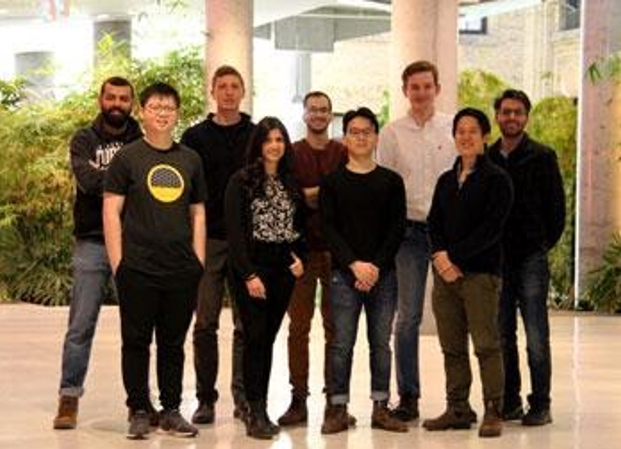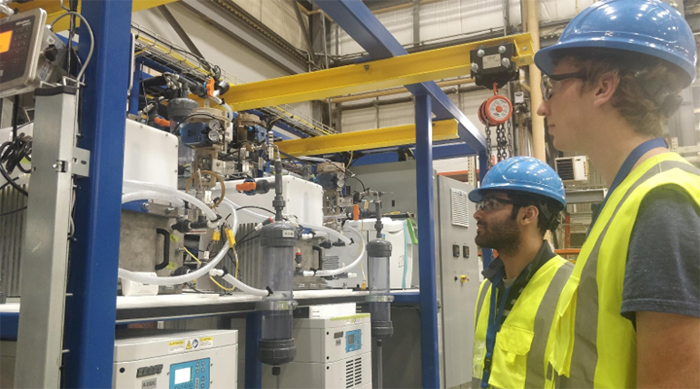|
|

|
  
Top Stories
Update 2020/2/22
Technology
CONVERTING CO2 INTO CHEMICAL FUELS – U OF T CARBONTECH GROUP GAINING NATIONAL AND GLOBAL RECOGNITION
By Suzanne Forcese
Water, electricity, and a catalyst. Add a team from the University of Toronto that has developed an electrochemical technology and voilà! carbon dioxide is converted into basic chemical feedstocks and fuels.
CERT, (Carbon Electro-catalytic Recycling Toronto) is a multidisciplinary team with expertise in chemistry, materials science and mechanical engineering based at the University of Toronto and led by Professor Ted Sargent and Professor Dave Sinton.
WaterToday spoke with Dr. Alexander Ip who is leading a team of 20 scientists, in developing technology for CO2 utilization – the basis of an XPRIZE team that is one of the global finalists in the $20M Carbon XPRIZE Competition. The challenge to the global finalists is to develop breakthrough technologies that will convert CO2 emissions from power plants and industrial facilities into valuable products.
Team CERT’s work on addressing the need for carbon-neutral fuel systems has focused on efficient reduction of atmospheric CO2 into usable products.
“The 9 members of the XPRIZE Team have just moved our system to the test site in Calgary. By early March we will flip the switch and ramp up our work,” Ip told us. The XPRIZE challenge will be completed by the end of June 2020.
The team will test their system’s ability to consume 2 tonnes of CO2 per day at the Alberta Carbon Conversion Technology Centre (ACCTC) operated by InnoTech Alberta. This will be a first for testing their solutions in the natural gas track of the competition. Here they will tap the flue emissions from a natural gas power plant where carbon dioxide will be converted into conventional petrochemicals.
Ip adds that “we are also honoured to be selected as a Breakthrough Canada winner.”
On February 12, 2020, Natural Resources Canada announced that CERT was one of the winners that could receive up to $3 million to develop their clean energy technologies with an opportunity to gain access to additional private investments.

CERT Team XPRIZE Finalists (left to right): Jehad Abed, Shijie Liu, Colin O’Brien,
Christine Gabardo, Joshua Wicks, Minh Lam, Johnathan Edwards, Alex Ip,
Armin Sedighian Rasouli - Photo Courtesy CERT
“Being one of the finalists in the XPRIZE has pushed up our mission. We have really accelerated our progress. The project began in 2016 with a unit the size of a rubic’s cube. Now it is the size of a small car. And as far as I know it is the largest in the world,” Ip said.
“Our technology is called electro-catalysis,” Ip adds. “We’re taking CO2 and renewable electricity as an input, as well as water. In the same way that you might split water to produce hydrogen we are splitting CO2 and producing new carbon products out of that.”
Ip told WT that because electricity grids are becoming cleaner and more cost efficient this is becoming a viable solution. “By using clean electricity – for example solar power, wind power, geothermal, or hydro-electric power – we are solving the CO2 problem.”
The new catalysts that CERT has developed are at the heart of the process of taking energy and water to produce synthetic fuels; and they allow a more efficient and cost effective process. “We discovered a new material in the lab and this is the basis for our technology. We have developed record performance catalysts for the reduction of CO2 into CO and the evolution of O2 from H2O—two key reactions needed to realize the goal of carbon-neutral fuel systems.”
“The production of ethylene is our main target because it goes into the production of almost everything from plastics, to textiles, solvents and a lot of consumer products. Currently, these are all products made from fossil fuels – a process that generates 2-4 tonnes of CO2 for every tonne of product.” Using CERT’s technology, up to 7 tonnes of CO2 emissions could be avoided when substituting conventional ethylene. In other words, there is potential for up to 1.4 GT in reductions. An ethylene market penetration of about 30% would enable 0.5 GT reductions when using renewable electricity.
Relative to fossil fuels, this technology runs on renewable energy. “Fortunately, the electricity grid in most provinces is very clean.” Ontario is entirely coal-free and Quebec and Manitoba have massive amounts of renewable hydroelectric power.
“This means our technology is uniquely positioned to make use of extra-capacity for long-term energy storage.” By taking excess produced energy from wind or solar power, converting it into a stable chemical form, such as liquid fuel to use later, the carbon loop is closed. Carbon dioxide becomes the energy carrier for renewable energy and allows the use of existing infrastructure that was built for fossil fuels.
“There’s still a lot of hard work ahead of us,” Ip adds.

Armin Sedighian Rasouli and Colin O’Brien Observing The Unit In Action
Photo Courtesy CERT (Carbon Electro-catalytic Recycling Toronto)
For intermittent sources such as solar and wind, CO2 electrolyzers could be used when electricity is produced in excess.
“Rather than selling electricity at well below cost, exportable chemicals and fuels could be synthesized. For example, excess solar electricity generated in the summer could be used to synthesize renewable fuels that could be used during the winter.”
“Being one of only 10 finalists of the $20M NRG Cosia Carbon XPRIZE a global competition to recognize leading carbon utilization technologies is encouraging. To be recognized by the likes of Bill Gates and other global influencers is a testament to the fact that a transition is coming.”
Ip adds that it is also encouraging that the Government of Canada is on the side of technical innovation. “My only hope is that the policy side of government and the big players will be in step. It will take some time.”
“But the transition is coming,” Alexander Ip concludes. There is CERTainty in that.
suzanne.f@watertoday.ca
|
|
|
Have a question? Give us a call 613-501-0175
All rights reserved 2025 - WATERTODAY - This material may not be reproduced in whole or in part and may not be distributed,
publicly performed, proxy cached or otherwise used, except with express permission.
|
| |